US Airline Industry: An Analysis of Porter's Competitive Strategy
VerifiedAdded on 2023/06/12
|6
|1080
|458
Essay
AI Summary
This essay provides an analysis of Porter's Competitive Strategies, including cost leadership, differentiation, and focus strategies, within the context of the US Airline Industry. It identifies specific airlines that have pursued each strategy, such as Southwest for cost leadership and American, United, and Delta for differentiation. The essay also discusses the concept of firms being 'stuck in the middle' and provides examples of airlines that fall into this category. The analysis offers insights into how these strategies are applied in a competitive industry and their potential impact on a company's profitability and market position. Desklib offers a wealth of similar resources for students seeking to deepen their understanding of business strategy.
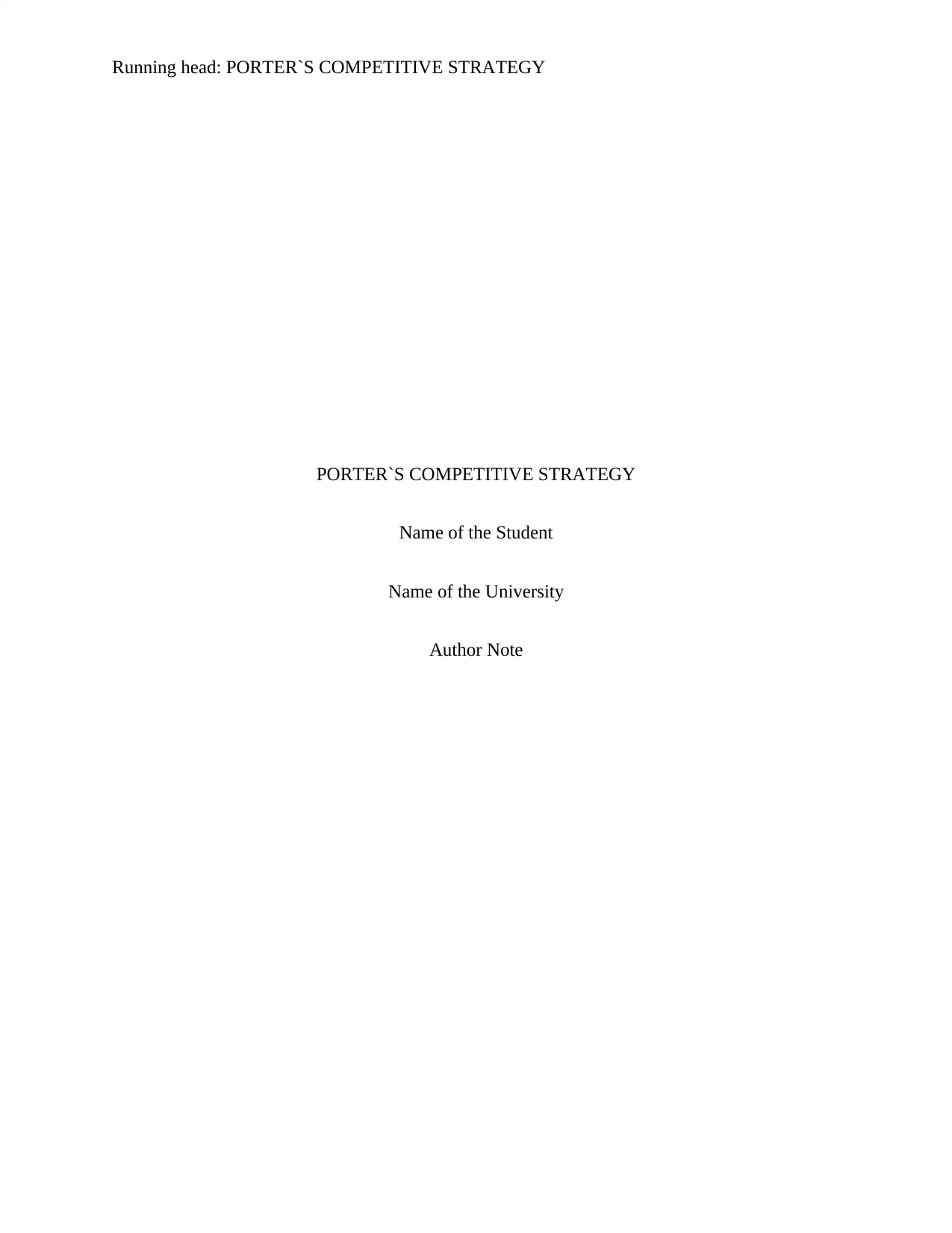
Running head: PORTER`S COMPETITIVE STRATEGY
PORTER`S COMPETITIVE STRATEGY
Name of the Student
Name of the University
Author Note
PORTER`S COMPETITIVE STRATEGY
Name of the Student
Name of the University
Author Note
Paraphrase This Document
Need a fresh take? Get an instant paraphrase of this document with our AI Paraphraser
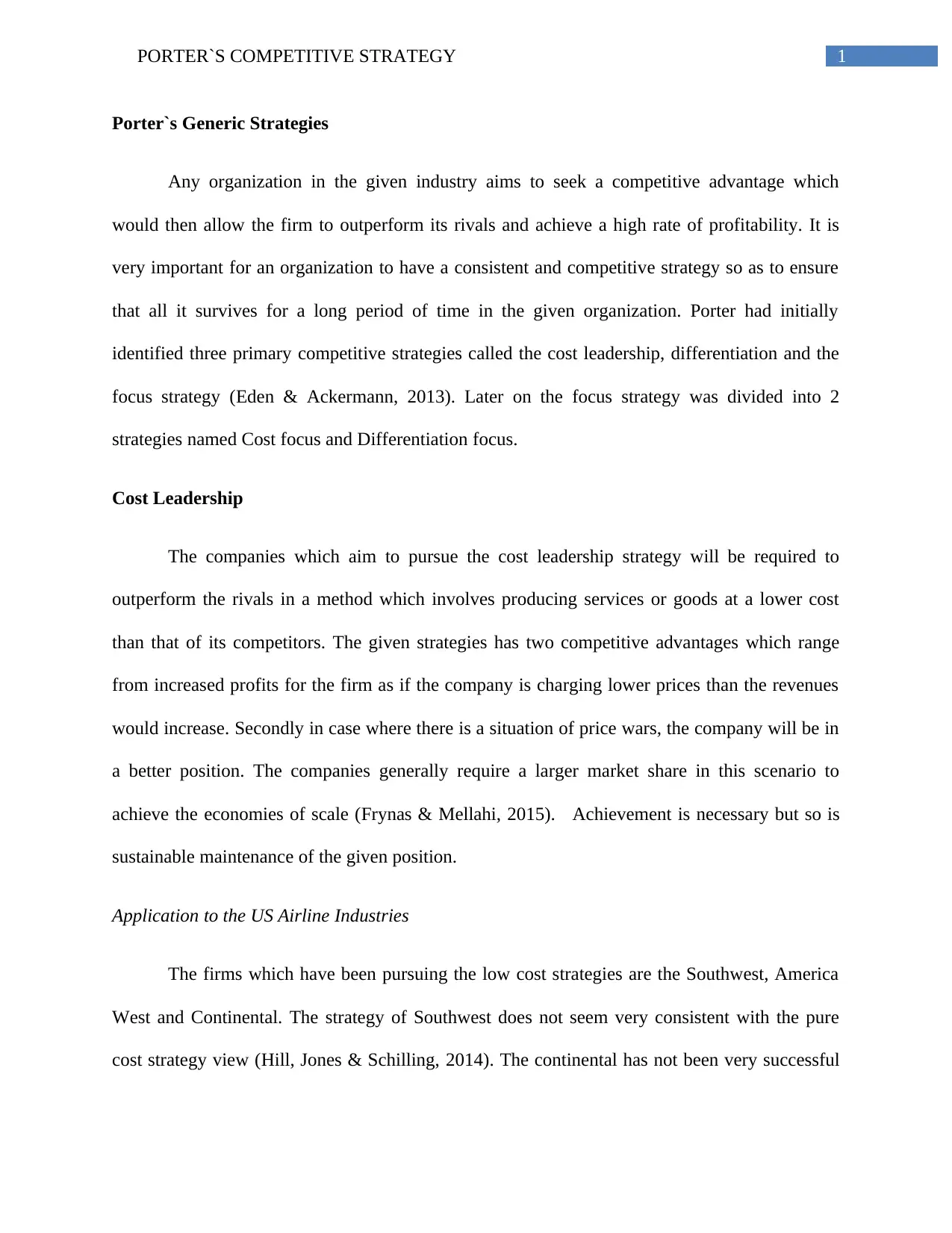
1PORTER`S COMPETITIVE STRATEGY
Porter`s Generic Strategies
Any organization in the given industry aims to seek a competitive advantage which
would then allow the firm to outperform its rivals and achieve a high rate of profitability. It is
very important for an organization to have a consistent and competitive strategy so as to ensure
that all it survives for a long period of time in the given organization. Porter had initially
identified three primary competitive strategies called the cost leadership, differentiation and the
focus strategy (Eden & Ackermann, 2013). Later on the focus strategy was divided into 2
strategies named Cost focus and Differentiation focus.
Cost Leadership
The companies which aim to pursue the cost leadership strategy will be required to
outperform the rivals in a method which involves producing services or goods at a lower cost
than that of its competitors. The given strategies has two competitive advantages which range
from increased profits for the firm as if the company is charging lower prices than the revenues
would increase. Secondly in case where there is a situation of price wars, the company will be in
a better position. The companies generally require a larger market share in this scenario to
achieve the economies of scale (Frynas & Mellahi, 2015). Achievement is necessary but so is
sustainable maintenance of the given position.
Application to the US Airline Industries
The firms which have been pursuing the low cost strategies are the Southwest, America
West and Continental. The strategy of Southwest does not seem very consistent with the pure
cost strategy view (Hill, Jones & Schilling, 2014). The continental has not been very successful
Porter`s Generic Strategies
Any organization in the given industry aims to seek a competitive advantage which
would then allow the firm to outperform its rivals and achieve a high rate of profitability. It is
very important for an organization to have a consistent and competitive strategy so as to ensure
that all it survives for a long period of time in the given organization. Porter had initially
identified three primary competitive strategies called the cost leadership, differentiation and the
focus strategy (Eden & Ackermann, 2013). Later on the focus strategy was divided into 2
strategies named Cost focus and Differentiation focus.
Cost Leadership
The companies which aim to pursue the cost leadership strategy will be required to
outperform the rivals in a method which involves producing services or goods at a lower cost
than that of its competitors. The given strategies has two competitive advantages which range
from increased profits for the firm as if the company is charging lower prices than the revenues
would increase. Secondly in case where there is a situation of price wars, the company will be in
a better position. The companies generally require a larger market share in this scenario to
achieve the economies of scale (Frynas & Mellahi, 2015). Achievement is necessary but so is
sustainable maintenance of the given position.
Application to the US Airline Industries
The firms which have been pursuing the low cost strategies are the Southwest, America
West and Continental. The strategy of Southwest does not seem very consistent with the pure
cost strategy view (Hill, Jones & Schilling, 2014). The continental has not been very successful
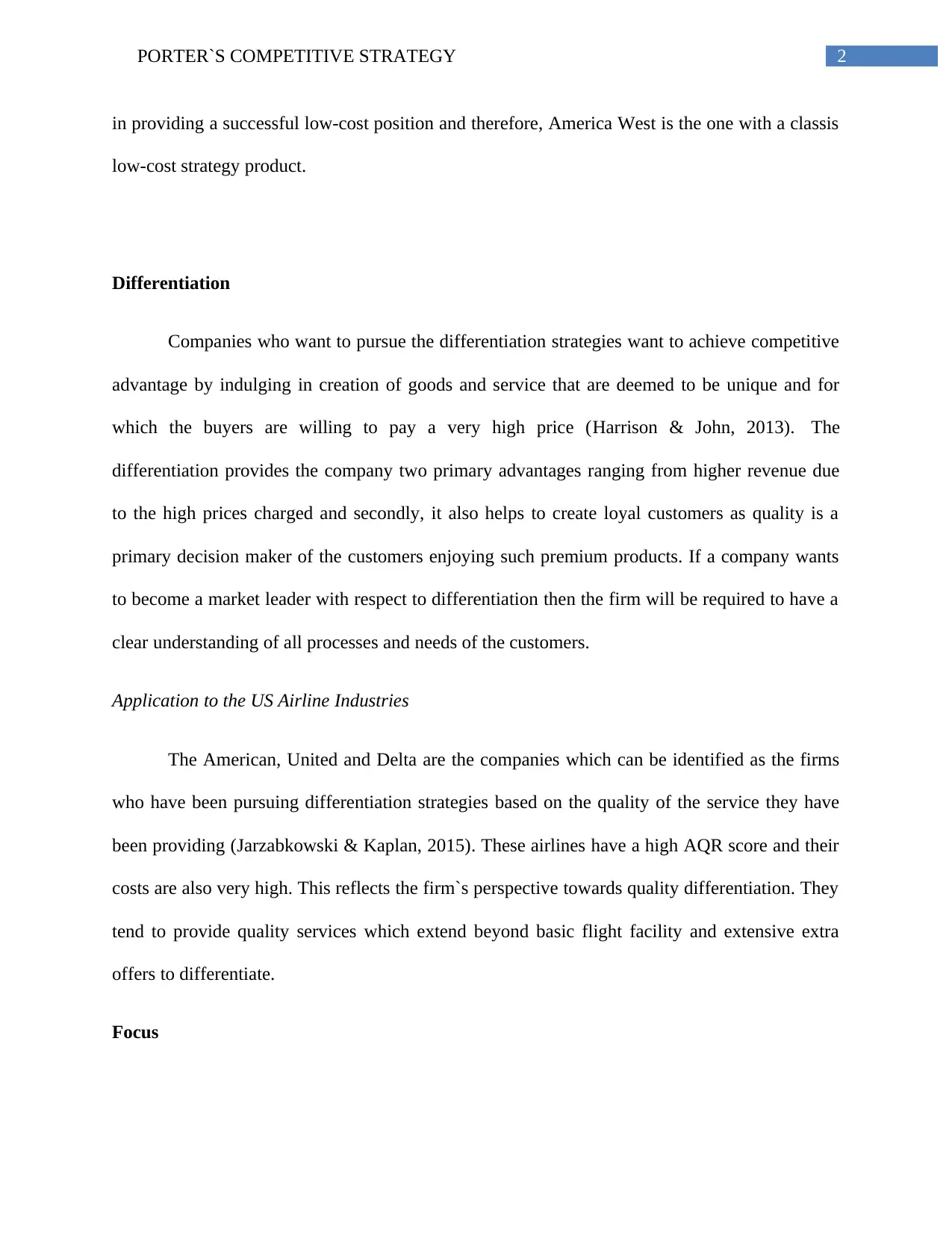
2PORTER`S COMPETITIVE STRATEGY
in providing a successful low-cost position and therefore, America West is the one with a classis
low-cost strategy product.
Differentiation
Companies who want to pursue the differentiation strategies want to achieve competitive
advantage by indulging in creation of goods and service that are deemed to be unique and for
which the buyers are willing to pay a very high price (Harrison & John, 2013). The
differentiation provides the company two primary advantages ranging from higher revenue due
to the high prices charged and secondly, it also helps to create loyal customers as quality is a
primary decision maker of the customers enjoying such premium products. If a company wants
to become a market leader with respect to differentiation then the firm will be required to have a
clear understanding of all processes and needs of the customers.
Application to the US Airline Industries
The American, United and Delta are the companies which can be identified as the firms
who have been pursuing differentiation strategies based on the quality of the service they have
been providing (Jarzabkowski & Kaplan, 2015). These airlines have a high AQR score and their
costs are also very high. This reflects the firm`s perspective towards quality differentiation. They
tend to provide quality services which extend beyond basic flight facility and extensive extra
offers to differentiate.
Focus
in providing a successful low-cost position and therefore, America West is the one with a classis
low-cost strategy product.
Differentiation
Companies who want to pursue the differentiation strategies want to achieve competitive
advantage by indulging in creation of goods and service that are deemed to be unique and for
which the buyers are willing to pay a very high price (Harrison & John, 2013). The
differentiation provides the company two primary advantages ranging from higher revenue due
to the high prices charged and secondly, it also helps to create loyal customers as quality is a
primary decision maker of the customers enjoying such premium products. If a company wants
to become a market leader with respect to differentiation then the firm will be required to have a
clear understanding of all processes and needs of the customers.
Application to the US Airline Industries
The American, United and Delta are the companies which can be identified as the firms
who have been pursuing differentiation strategies based on the quality of the service they have
been providing (Jarzabkowski & Kaplan, 2015). These airlines have a high AQR score and their
costs are also very high. This reflects the firm`s perspective towards quality differentiation. They
tend to provide quality services which extend beyond basic flight facility and extensive extra
offers to differentiate.
Focus
⊘ This is a preview!⊘
Do you want full access?
Subscribe today to unlock all pages.

Trusted by 1+ million students worldwide
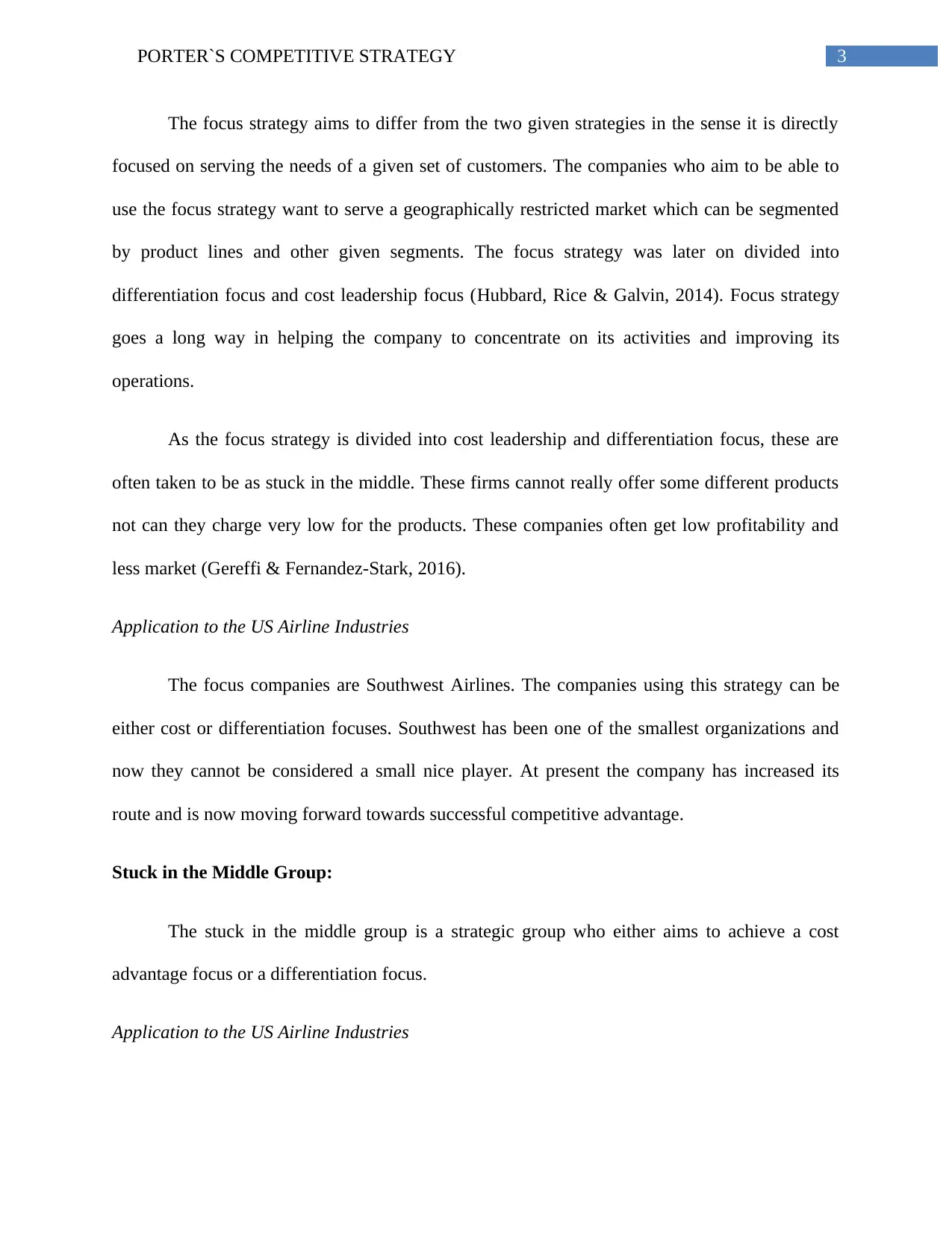
3PORTER`S COMPETITIVE STRATEGY
The focus strategy aims to differ from the two given strategies in the sense it is directly
focused on serving the needs of a given set of customers. The companies who aim to be able to
use the focus strategy want to serve a geographically restricted market which can be segmented
by product lines and other given segments. The focus strategy was later on divided into
differentiation focus and cost leadership focus (Hubbard, Rice & Galvin, 2014). Focus strategy
goes a long way in helping the company to concentrate on its activities and improving its
operations.
As the focus strategy is divided into cost leadership and differentiation focus, these are
often taken to be as stuck in the middle. These firms cannot really offer some different products
not can they charge very low for the products. These companies often get low profitability and
less market (Gereffi & Fernandez-Stark, 2016).
Application to the US Airline Industries
The focus companies are Southwest Airlines. The companies using this strategy can be
either cost or differentiation focuses. Southwest has been one of the smallest organizations and
now they cannot be considered a small nice player. At present the company has increased its
route and is now moving forward towards successful competitive advantage.
Stuck in the Middle Group:
The stuck in the middle group is a strategic group who either aims to achieve a cost
advantage focus or a differentiation focus.
Application to the US Airline Industries
The focus strategy aims to differ from the two given strategies in the sense it is directly
focused on serving the needs of a given set of customers. The companies who aim to be able to
use the focus strategy want to serve a geographically restricted market which can be segmented
by product lines and other given segments. The focus strategy was later on divided into
differentiation focus and cost leadership focus (Hubbard, Rice & Galvin, 2014). Focus strategy
goes a long way in helping the company to concentrate on its activities and improving its
operations.
As the focus strategy is divided into cost leadership and differentiation focus, these are
often taken to be as stuck in the middle. These firms cannot really offer some different products
not can they charge very low for the products. These companies often get low profitability and
less market (Gereffi & Fernandez-Stark, 2016).
Application to the US Airline Industries
The focus companies are Southwest Airlines. The companies using this strategy can be
either cost or differentiation focuses. Southwest has been one of the smallest organizations and
now they cannot be considered a small nice player. At present the company has increased its
route and is now moving forward towards successful competitive advantage.
Stuck in the Middle Group:
The stuck in the middle group is a strategic group who either aims to achieve a cost
advantage focus or a differentiation focus.
Application to the US Airline Industries
Paraphrase This Document
Need a fresh take? Get an instant paraphrase of this document with our AI Paraphraser
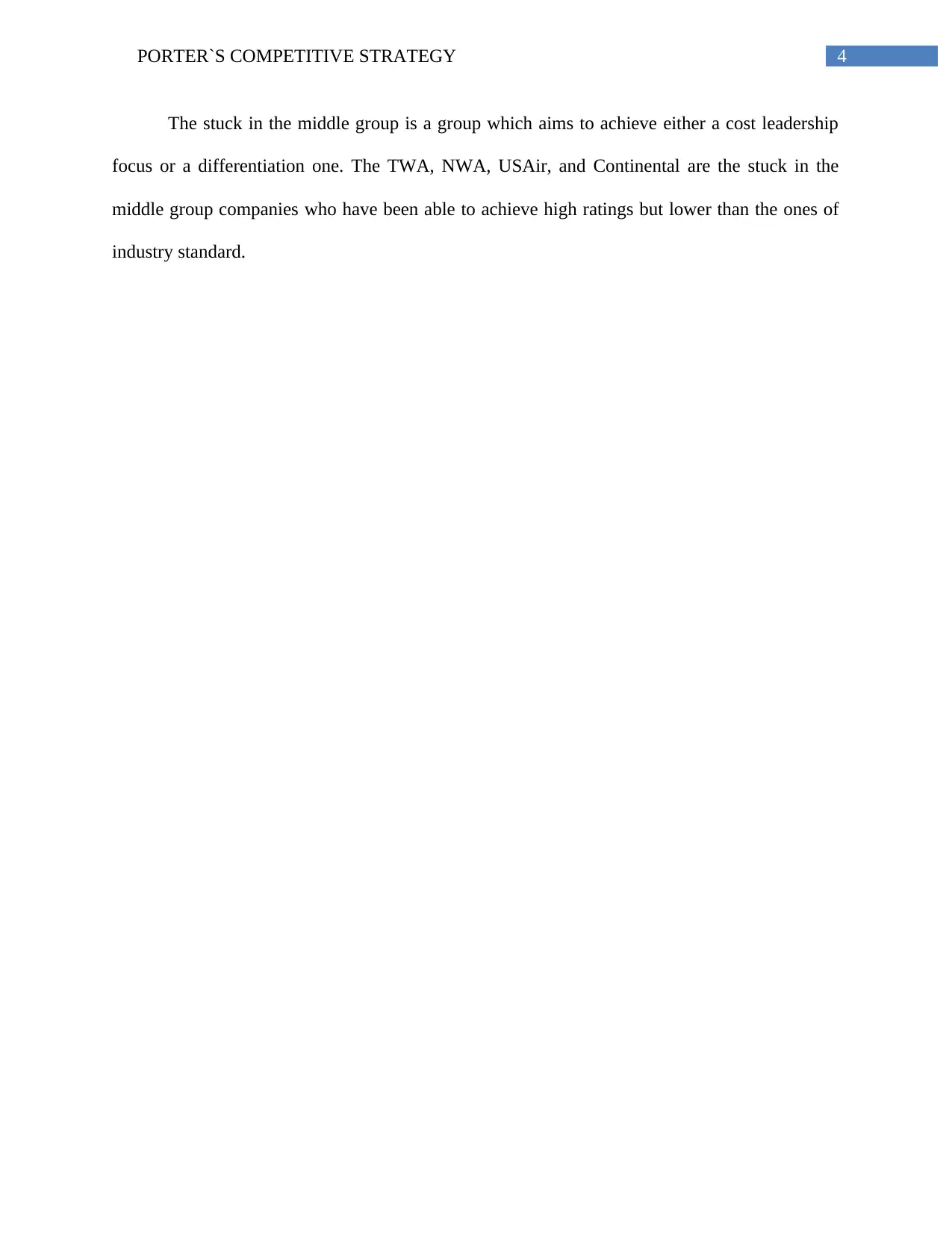
4PORTER`S COMPETITIVE STRATEGY
The stuck in the middle group is a group which aims to achieve either a cost leadership
focus or a differentiation one. The TWA, NWA, USAir, and Continental are the stuck in the
middle group companies who have been able to achieve high ratings but lower than the ones of
industry standard.
The stuck in the middle group is a group which aims to achieve either a cost leadership
focus or a differentiation one. The TWA, NWA, USAir, and Continental are the stuck in the
middle group companies who have been able to achieve high ratings but lower than the ones of
industry standard.
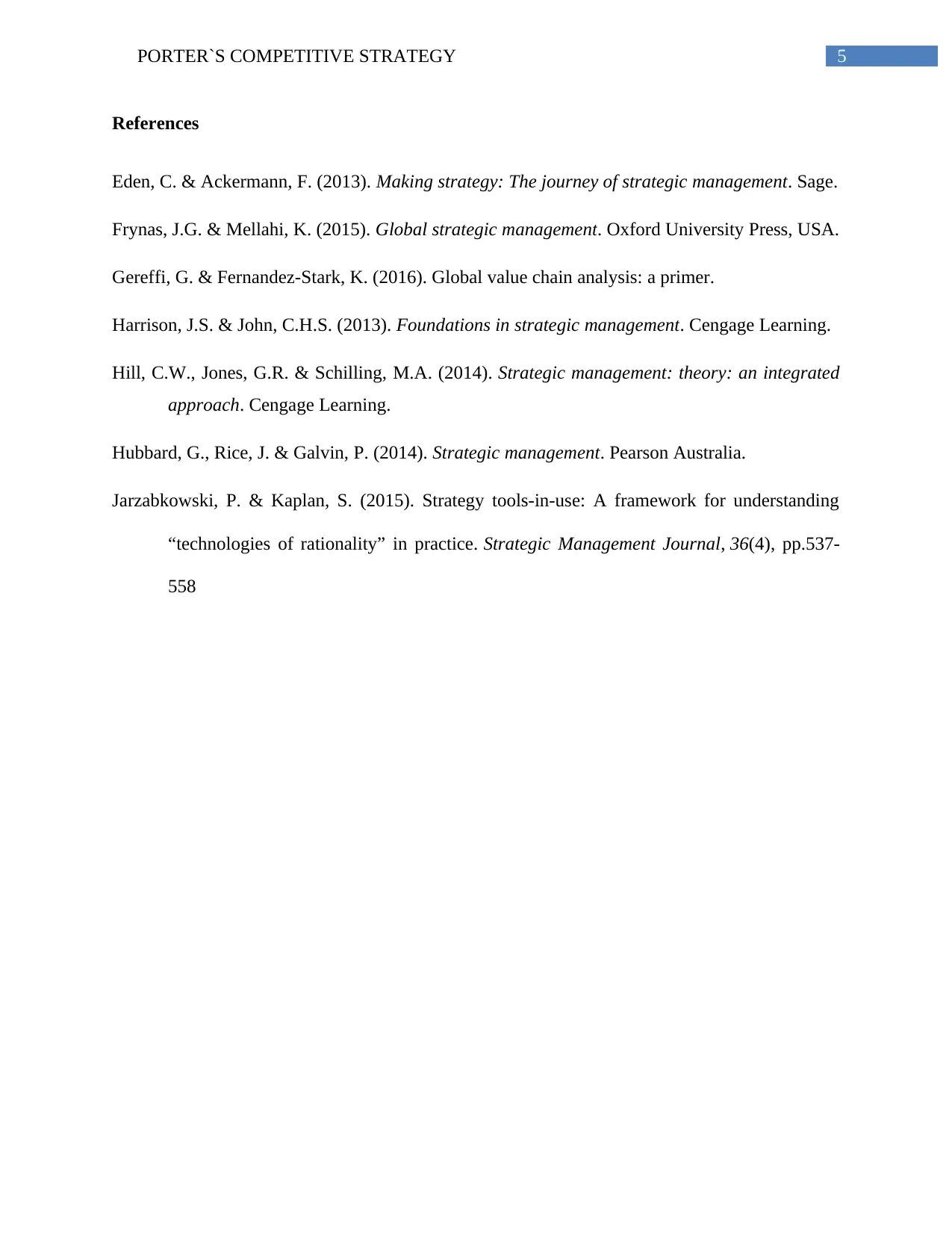
5PORTER`S COMPETITIVE STRATEGY
References
Eden, C. & Ackermann, F. (2013). Making strategy: The journey of strategic management. Sage.
Frynas, J.G. & Mellahi, K. (2015). Global strategic management. Oxford University Press, USA.
Gereffi, G. & Fernandez-Stark, K. (2016). Global value chain analysis: a primer.
Harrison, J.S. & John, C.H.S. (2013). Foundations in strategic management. Cengage Learning.
Hill, C.W., Jones, G.R. & Schilling, M.A. (2014). Strategic management: theory: an integrated
approach. Cengage Learning.
Hubbard, G., Rice, J. & Galvin, P. (2014). Strategic management. Pearson Australia.
Jarzabkowski, P. & Kaplan, S. (2015). Strategy tools‐in‐use: A framework for understanding
“technologies of rationality” in practice. Strategic Management Journal, 36(4), pp.537-
558
References
Eden, C. & Ackermann, F. (2013). Making strategy: The journey of strategic management. Sage.
Frynas, J.G. & Mellahi, K. (2015). Global strategic management. Oxford University Press, USA.
Gereffi, G. & Fernandez-Stark, K. (2016). Global value chain analysis: a primer.
Harrison, J.S. & John, C.H.S. (2013). Foundations in strategic management. Cengage Learning.
Hill, C.W., Jones, G.R. & Schilling, M.A. (2014). Strategic management: theory: an integrated
approach. Cengage Learning.
Hubbard, G., Rice, J. & Galvin, P. (2014). Strategic management. Pearson Australia.
Jarzabkowski, P. & Kaplan, S. (2015). Strategy tools‐in‐use: A framework for understanding
“technologies of rationality” in practice. Strategic Management Journal, 36(4), pp.537-
558
⊘ This is a preview!⊘
Do you want full access?
Subscribe today to unlock all pages.

Trusted by 1+ million students worldwide
1 out of 6
Related Documents
Your All-in-One AI-Powered Toolkit for Academic Success.
+13062052269
info@desklib.com
Available 24*7 on WhatsApp / Email
![[object Object]](/_next/static/media/star-bottom.7253800d.svg)
Unlock your academic potential
Copyright © 2020–2025 A2Z Services. All Rights Reserved. Developed and managed by ZUCOL.





